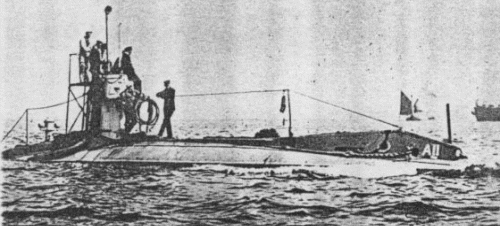

A3 1905
| Name | No | Yard No | Builder | Laid down | Launched | Comp | Fate |
| A1 (ex-No 6) | Vickers, Barrow | 2.1902 | 9.7.1902 | 7.1903 | collision 18.3.1904 | ||
| A2 | Vickers, Barrow | 11.1902 | 16.4.1903 | 6.1904 | wrecked 1.1920 | ||
| A3 | Vickers, Barrow | 11.1902 | 9.3.1903 | 7.1904 | collision 2.2.1912 | ||
| A4 | Vickers, Barrow | 2.1903 | 9.6.1903 | 7.1904 | sold 1.1920 | ||
| A5 | I15 | Vickers, Barrow | 9.1903 | 3.3.1904 | 2.1905 | sold 1.1920 | |
| A6 | I16 | Vickers, Barrow | 9.1903 | 3.3.1904 | 3.1905 | sold 1.1920 | |
| A7 | Vickers, Barrow | 9.1903 | 23.1.1905 | 4.1905 | lost 16.1.1914 | ||
| A8 | I18 | Vickers, Barrow | 9.1903 | 23.1.1905 | 5.1905 | stricken 7.1916 | |
| A9 | I19 | Vickers, Barrow | 1903 | 8.2.1905 | 5.1905 | BU 1920 | |
| A10 | I10 | Vickers, Barrow | 1903 | 8.2.1905 | 6.1905 | sold 4.1919 | |
| A11 | I01 | Vickers, Barrow | 1903 | 8.3.1905 | 7.1905 | BU 5.1920 | |
| A12 | I02 | Vickers, Barrow | 1903 | 8.3.1905 | 9.1905 | sold 1.1920 | |
| A13 | I03 | Vickers, Barrow | 1903 | 18.4.1905 | 6.1908 | BU 1920 |
|
Displacement standard, t |
|
|
Displacement normal, t |
A1 - 4: 165 / 180 A5 - 13: 180 / 207 |
|
Length, m |
A1 - 4: 30.5 A5 - 13: 30.2 |
|
Breadth, m |
A1 - 4: 3.51 A5 - 13: 3.89 |
|
Draught, m |
3.05 |
|
No of shafts |
1 |
|
Machinery |
A1 - 12: 1 petrol engine / 1 electric motor A13: 1 diesel / 1 electric motor |
|
Power, h. p. |
A1 - 4: 450 / 80 A5 - 12: 550 / 150 A13: 400 / 150 |
|
Max speed, kts |
A1 - 4: 11.5 / 7 A5 - 12: 12 / 8 A13: 11 / 8 |
|
Fuel, t |
A1 - 12: petrol 7 A13: diesel oil 5 |
| Endurance, nm(kts) | 500(10) / 30(5) |
|
Armament |
A1: 1 - 450 TT (bow, 3) A2 - 13: 2 - 450 TT (bow, 4) |
|
Complement |
A1 - 4: 11 A5 - 13: 13 |
| Diving depth operational, m | 30 |
Project history: A sixth improved unit of the 'Holland' class was so altered at the design stage that she became the prototype for the next class, the first all-British submarines. A1 was little more than a lengthened Holland, but from A5 onwards they were enlarged and from A2 carried a second TT in a side-by-side configuration. Another innovation was a proper conning tower, to avoid being swamped when running on the surface. Like the 'Hollands' their main defect was the small reserve of buoyancy. Although still largely experimental the 'A' boats were successful, and the survivors saw active service in 1914, even if only in the training role. Protracted trials with A13's Hornsby-Ackroyd vertical heavy oil engine led to the adoption of the diesel in due course, and the basic concepts remained unaltered for several years.
Modernizations: None.
Naval service: A1 was laid down before Holland No1 had completed her trials, and came into service in July 1903. Unfortunately she was the first submarine casualty, being rammed and sunk on 18 March 1904 by the liner Berwick Castle off the Nab. Raised on 18 April 1904 she was never recommissioned, and was sunk as a target. A2 was wrecked while on the Sale List. A3 was rammed and sunk by Hazard on 2 February 1912 but raised and used as a target. A4 was sunk in collision on 16 October 1905, and although raised was not recommissioned. A7 was lost in Whitesand Bay when she dived into the mud. A8 foundered and sank in Plymouth Sound on 8 June 1905 but was raised and repaired; stricken July 1916 and sold in January, 1920.

A11 1910s
© Ivan Gogin, 2008-13